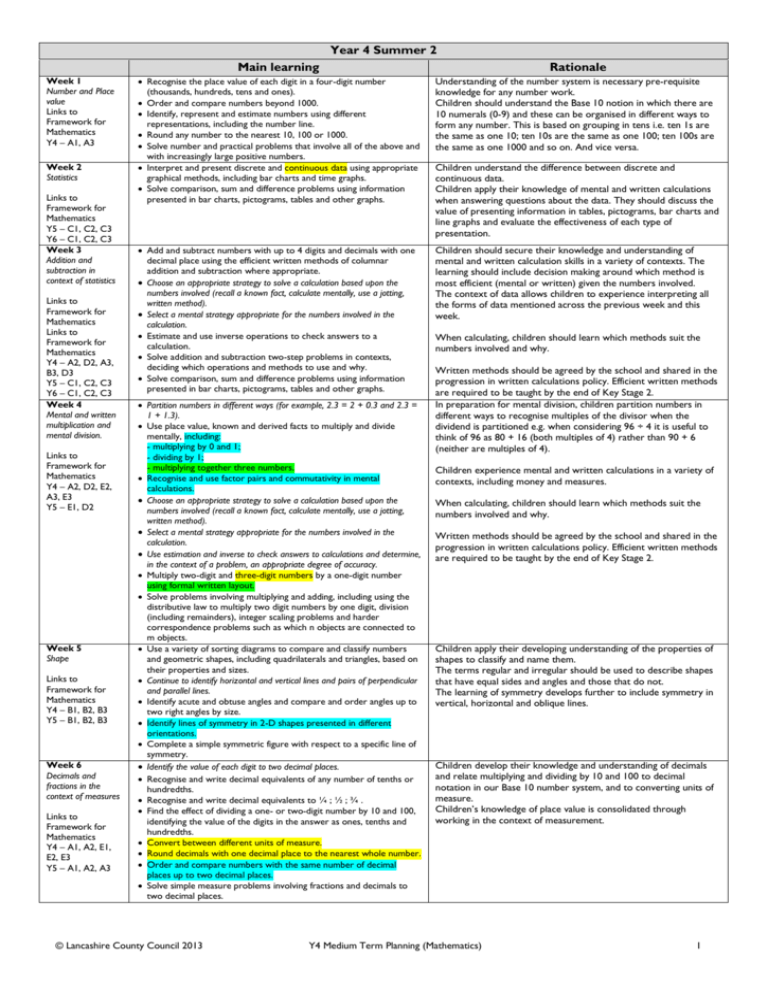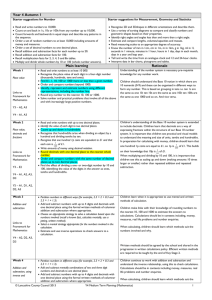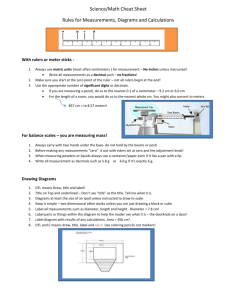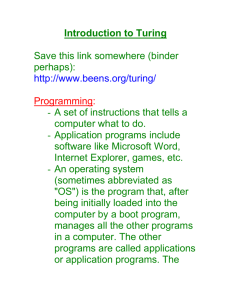Year 4 Summer 2 Main learning Rationale Week 1 Number and
advertisement

Year 4 Summer 2 Main learning Week 1 Number and Place value Links to Framework for Mathematics Y4 – A1, A3 Week 2 Statistics Links to Framework for Mathematics Y5 – C1, C2, C3 Y6 – C1, C2, C3 Week 3 Addition and subtraction in context of statistics Links to Framework for Mathematics Links to Framework for Mathematics Y4 – A2, D2, A3, B3, D3 Y5 – C1, C2, C3 Y6 – C1, C2, C3 Week 4 Mental and written multiplication and mental division. Links to Framework for Mathematics Y4 – A2, D2, E2, A3, E3 Y5 – E1, D2 Week 5 Shape Links to Framework for Mathematics Y4 – B1, B2, B3 Y5 – B1, B2, B3 Week 6 Decimals and fractions in the context of measures Links to Framework for Mathematics Y4 – A1, A2, E1, E2, E3 Y5 – A1, A2, A3 Rationale Recognise the place value of each digit in a four-digit number (thousands, hundreds, tens and ones). Order and compare numbers beyond 1000. Identify, represent and estimate numbers using different representations, including the number line. Round any number to the nearest 10, 100 or 1000. Solve number and practical problems that involve all of the above and with increasingly large positive numbers. Interpret and present discrete and continuous data using appropriate graphical methods, including bar charts and time graphs. Solve comparison, sum and difference problems using information presented in bar charts, pictograms, tables and other graphs. Understanding of the number system is necessary pre-requisite knowledge for any number work. Children should understand the Base 10 notion in which there are 10 numerals (0-9) and these can be organised in different ways to form any number. This is based on grouping in tens i.e. ten 1s are the same as one 10; ten 10s are the same as one 100; ten 100s are the same as one 1000 and so on. And vice versa. Add and subtract numbers with up to 4 digits and decimals with one decimal place using the efficient written methods of columnar addition and subtraction where appropriate. Choose an appropriate strategy to solve a calculation based upon the numbers involved (recall a known fact, calculate mentally, use a jotting, written method). Select a mental strategy appropriate for the numbers involved in the calculation. Estimate and use inverse operations to check answers to a calculation. Solve addition and subtraction two-step problems in contexts, deciding which operations and methods to use and why. Solve comparison, sum and difference problems using information presented in bar charts, pictograms, tables and other graphs. Children should secure their knowledge and understanding of mental and written calculation skills in a variety of contexts. The learning should include decision making around which method is most efficient (mental or written) given the numbers involved. The context of data allows children to experience interpreting all the forms of data mentioned across the previous week and this week. Partition numbers in different ways (for example, 2.3 = 2 + 0.3 and 2.3 = 1 + 1.3). Use place value, known and derived facts to multiply and divide mentally, including: - multiplying by 0 and 1; - dividing by 1; - multiplying together three numbers. Recognise and use factor pairs and commutativity in mental calculations. Choose an appropriate strategy to solve a calculation based upon the numbers involved (recall a known fact, calculate mentally, use a jotting, written method). Select a mental strategy appropriate for the numbers involved in the calculation. Use estimation and inverse to check answers to calculations and determine, in the context of a problem, an appropriate degree of accuracy. Multiply two-digit and three-digit numbers by a one-digit number using formal written layout. Solve problems involving multiplying and adding, including using the distributive law to multiply two digit numbers by one digit, division (including remainders), integer scaling problems and harder correspondence problems such as which n objects are connected to m objects. Use a variety of sorting diagrams to compare and classify numbers and geometric shapes, including quadrilaterals and triangles, based on their properties and sizes. Continue to identify horizontal and vertical lines and pairs of perpendicular and parallel lines. Identify acute and obtuse angles and compare and order angles up to two right angles by size. Identify lines of symmetry in 2-D shapes presented in different orientations. Complete a simple symmetric figure with respect to a specific line of symmetry. Identify the value of each digit to two decimal places. Recognise and write decimal equivalents of any number of tenths or hundredths. Recognise and write decimal equivalents to ¼ ; ½ ; ¾ . Find the effect of dividing a one- or two-digit number by 10 and 100, identifying the value of the digits in the answer as ones, tenths and hundredths. Convert between different units of measure. Round decimals with one decimal place to the nearest whole number. Order and compare numbers with the same number of decimal places up to two decimal places. Solve simple measure problems involving fractions and decimals to two decimal places. © Lancashire County Council 2013 Children understand the difference between discrete and continuous data. Children apply their knowledge of mental and written calculations when answering questions about the data. They should discuss the value of presenting information in tables, pictograms, bar charts and line graphs and evaluate the effectiveness of each type of presentation. When calculating, children should learn which methods suit the numbers involved and why. Written methods should be agreed by the school and shared in the progression in written calculations policy. Efficient written methods are required to be taught by the end of Key Stage 2. In preparation for mental division, children partition numbers in different ways to recognise multiples of the divisor when the dividend is partitioned e.g. when considering 96 ÷ 4 it is useful to think of 96 as 80 + 16 (both multiples of 4) rather than 90 + 6 (neither are multiples of 4). Children experience mental and written calculations in a variety of contexts, including money and measures. When calculating, children should learn which methods suit the numbers involved and why. Written methods should be agreed by the school and shared in the progression in written calculations policy. Efficient written methods are required to be taught by the end of Key Stage 2. Children apply their developing understanding of the properties of shapes to classify and name them. The terms regular and irregular should be used to describe shapes that have equal sides and angles and those that do not. The learning of symmetry develops further to include symmetry in vertical, horizontal and oblique lines. Children develop their knowledge and understanding of decimals and relate multiplying and dividing by 10 and 100 to decimal notation in our Base 10 number system, and to converting units of measure. Children’s knowledge of place value is consolidated through working in the context of measurement. Y4 Medium Term Planning (Mathematics) 1







